2020 in Review
Outlook for 2021 & Beyond
Contributors: This document was prepared by Andy Lee, Tong Luo and Mathieu De Marchi of our Asia-Pacific Division and Matthew Lee and Mike Bown of our Americas Division with the editorial assistance of Richard Barone of our Americas Division.
Table of Contents
- 2020 in Review
- Worldwide Decline in Commercial Aircraft Operations
- Domestic Travel Recovery in Some Parts of the Asia-Pacific Region
- International Traffic has Largely Disappeared
- US Airports Lost Varying Amounts of Aircraft Traffic
- Chinese Domestic Seating Capacity Rose in the Second Half of 2020
- Change in Demand Reshuffles Top Ten Airport Lists in China and the U.S.
- International Travel Restrictions Vary by Country
- Travel This Year
- Beyond 2021
2020 in Review
COVID-19 was an unforeseen challenge to the worldwide aviation industry that dramatically curtailed air travel. Some airlines quickly adapted their networks to a new smaller market reality. Airlines experimented with new routes and eventually found markets that could sustain much of their operations until normal travel patterns re-emerged. Other airlines chose to retrench by parking most of their aircraft and consolidating operations into their traditional larger hubs. This brief examines the impact that COVID-19 has had on airports in the Asia-Pacific Region and the Americas during 2020 and considers what the recovery might look like in 2021 and beyond.
Worldwide Decline in Commercial Aircraft Operations
Worldwide commercial flights dropped to only 30% of 2019 volumes during the early days of the pandemic in April 2020. Now, almost a year later, the number of commercial flights has increased to 70% of 2019 levels. Much of the increase has occurred in the past few months as airlines have resumed more flights in response to changes in passenger demand.
Worldwide non-commercial flights initially dropped to approximately 60% of their 2019 volume, but by July 2020, volumes had recovered to 2019 levels. Starting in November 2020, non-commercial flights exceeded 2019 volumes and, in the start of 2021, non-commercial activity has continued to grow. Non-commercial flights are predominantly flown by private and business aircraft, which carry very few passengers.
Passengers who can afford using private aircraft are taking advantage of what they perceive as a safer aviation alternative.
Domestic Travel Recovery in Some Parts of the Asia-Pacific Region
Monthly seating capacity varied widely in the Asia-Pacific region. Seating capacity losses were sustained from March 2020 and onwards, yet capacity still has not recovered in most countries. The impact of COVID-19 on domestic capacity was the greatest in Australasia. As of Feb 2021, domestic activity remains 44% below pre-COVID levels. This is due to mandated lockdowns and state government policies preventing travel between states/territories and the decrease in passenger confidence. In East Asia (China, Japan and the Koreas), seating capacities fell rapidly in February 2020 but had recovered to 2019 levels by mid-year. China has been a major driver of traffic trends in East Asia showing traffic above pre COVID-19 levels by mid-2020. In order to avoid another outbreak during the 2021 Chinese New Year, the Chinese government urged people not to travel for New Year celebrations and implemented new domestic travel COVID testing requirements, which resulted in a sharp decline of 19% in domestic capacity in Feb 2021 compared to 2019. Domestic traffic in Southeast Asia also experienced a robust rebound in the middle of 2020. However, recent outbreaks triggered new lockdowns and drops in domestic activity from December 2020 and into the first quarter of 2021. South Asia (led by India) and the Middle East have consistently recovered throughout 2020 to reach about 80% of pre COVID-19 levels in Feb 2021.
Worldwide Total Daily Commercial Flights
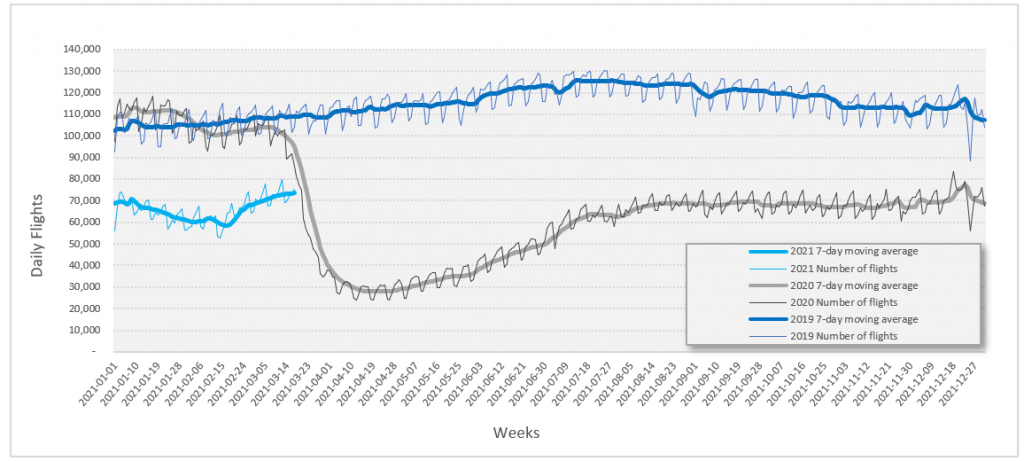
Source: Flight Tracking Statistics, Flight Radar
Worldwide Non-Commercial Flights
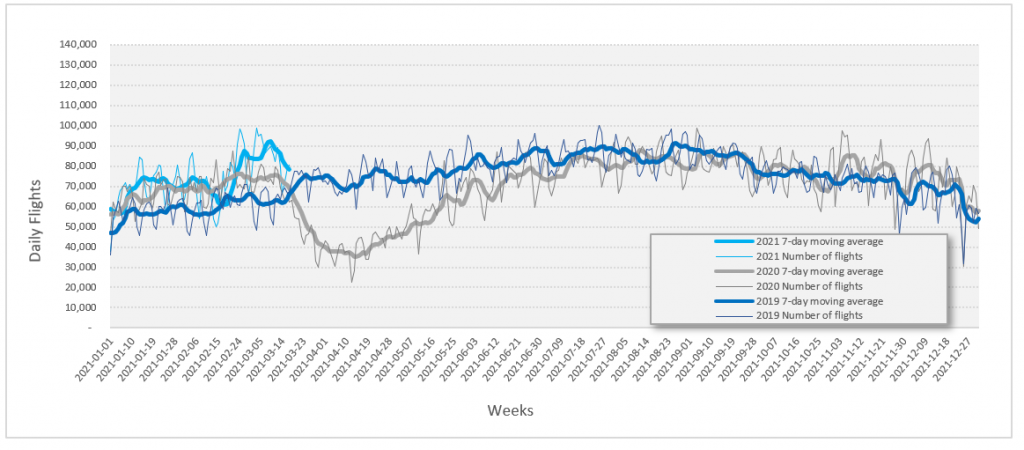
Source: Flight Tracking Statistics, Flight Radar
International Traffic has Largely Disappeared
International seating capacity dropped sharply across Asia-Pacific in April 2020 and has remained depressed since. While Middle East and South Asia have shown some level of recover over time, Australasia, East Asia and South East Asia international capacity remains about 90% below pre COVID-19 levels with limited signs of recovery.
Most countries in the region still impose drastic travel restrictions and require fit-to-fly certificates along with negative COVID-19 test and 14 to 21-day quarantine for arriving international passengers. Given that most travel itineraries are shorter than 14 days, these restrictions have effectively acted as a deterrent for most people wanting to travel except for repatriations.
Asia Pacific Region Monthly Scheduled Domestic and International Seating Capacity
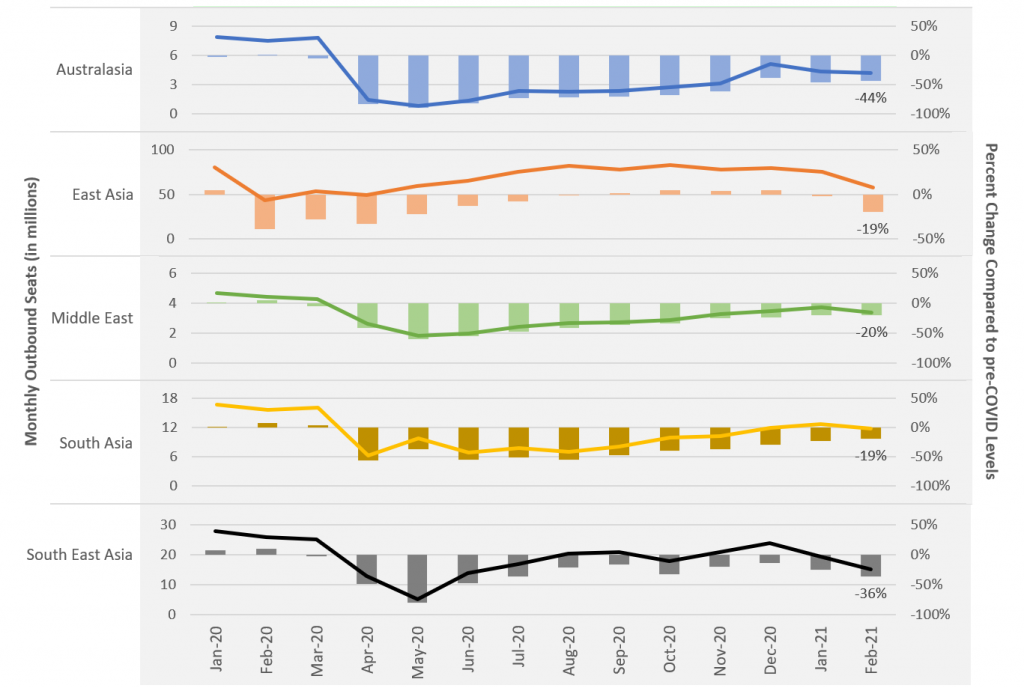
Source: Diio Mi Schedule Data by Cirium
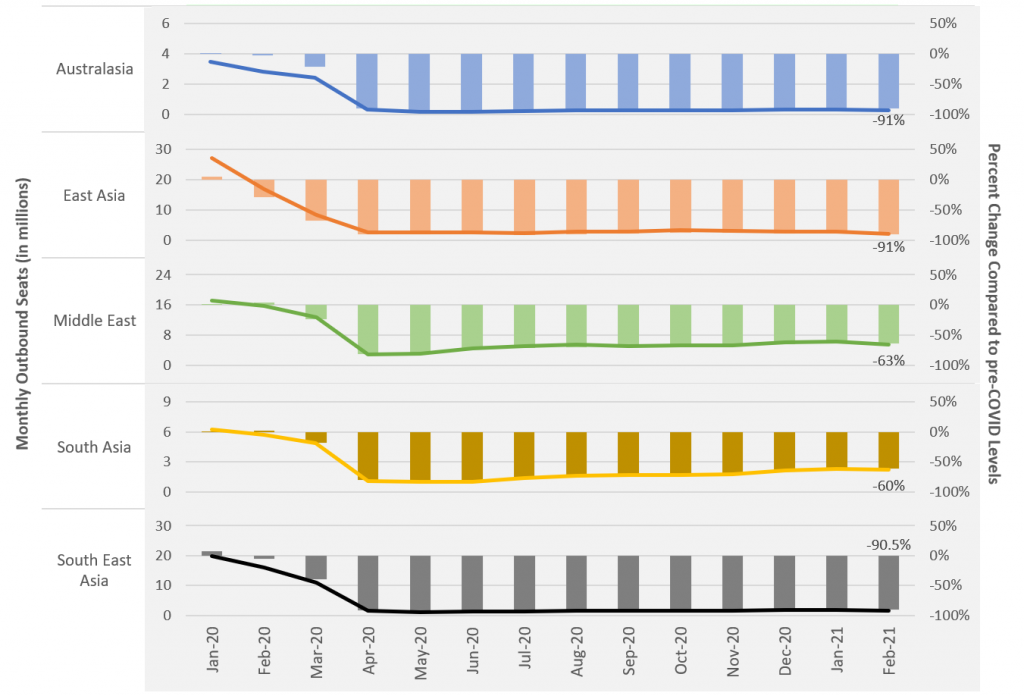
US Airports Lost Varying Amounts of Aircraft Traffic
Airports experienced uneven traffic losses as a result of pandemic-induced airline service changes. U.S. airports that serve mountain or beach leisure destinations or have large cargo hubs suffered the least aircraft traffic losses.
Airports with hubs for airlines such as Southwest, Spirit, and American also fared well. Airports with international gateway hubs or located in large urban markets have much higher losses of aircraft traffic.
Percentage Traffic Lost at 45 U.S. Large Airport from 2019 to 2020
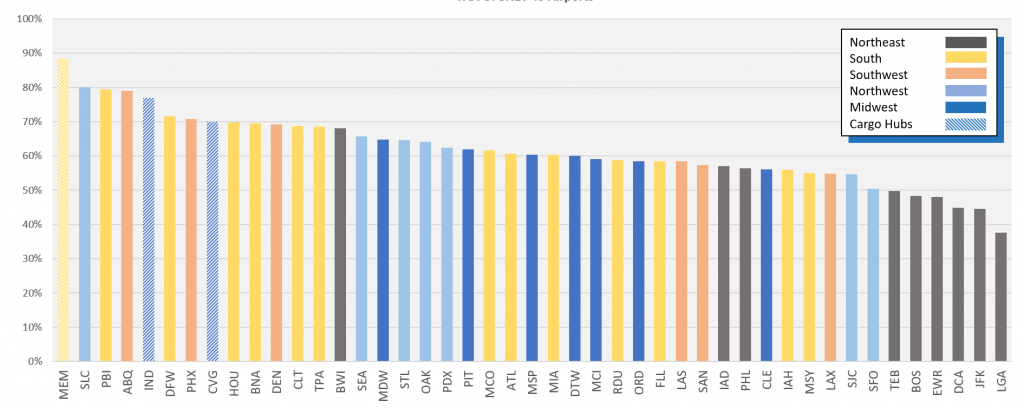
Source: FAA Aviation System Performance Metrics – https://aspm.faa.gov/opsnet/sys/main.asp Accessed, 5 January 2021
Chinese Domestic Seating Capacity Rose in the Second Half of 2020
Chinese domestic airline seating capacity in the second half of 2020 was 8% greater than the same period in 2019. Unlike the U.S. where domestic business travel has stalled, domestic business travel in China has returned to the skies primarily due to the effective control of the pandemic since in the first quarter of 2020. Inbound and outbound international travel has largely ceased in both countries because of the 14-day quarantine requirements for arriving international passengers.
Traffic losses were greatest at airports such as Beijing Capital International Airport (PEK) and Shanghai Pudong International Airport (PVG) that serve as major international gateway hubs. Other airports that serve predominantly domestic traffic have had far smaller traffic losses.
Monthly Total Chinese Airline Domestic and International Scheduled Seating Capacity
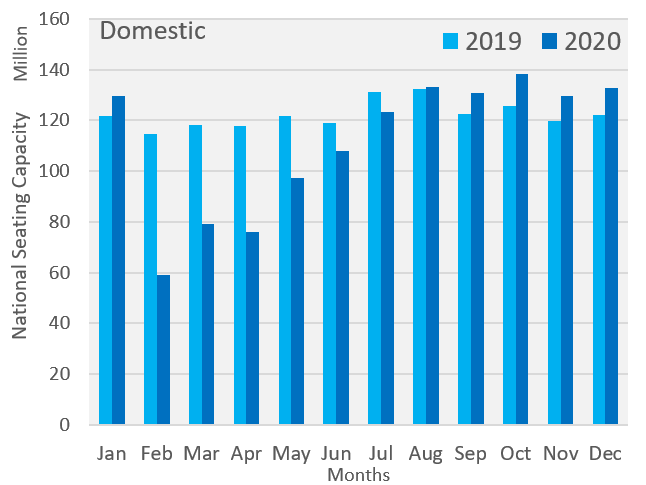
Source: Diio Mi Schedule Data by Cirium
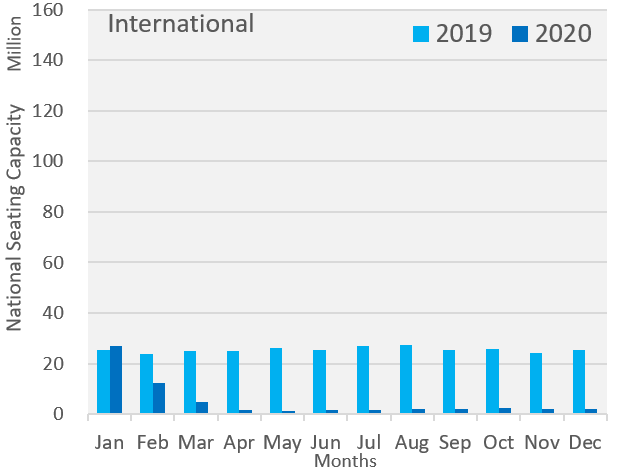
Due to the absence of domestic travel markets, traffic at Hong Kong International Airport (HKG), Macau International Airport (MFM), and Taipei International Airport (TPE) had far greater declines than in the rest of China. Passenger traffic for HKG collapsed from 71.5 Million Annual Passengers (MAP) in 2019 to 8.8 MAP in 2020; MFM from 9.6 MAP to 1.2 MAP; and TPE from 48.7 MAP to 7.44 MAP. Combined, all three airports experienced a staggering 85% reduction in passenger traffic.
Change in Demand Reshuffles Top Ten Airport Lists in China and the U.S.
As result of the dramatic losses of air travelers, the China and U.S. list of top ten airports changed. While China’s list of top ten airports in 2020 includes the same airports as 2019, the order of the airports is different. Airports that had higher portions of international traffic lost more traffic. PVG and PEK dropped seven and four places in the rankings respectively.
Also, PEK lost traffic to the newly opened Beijing Daxing Airport (PKX). Eight of the top ten Chinese airports in 2020 had passenger volumes that declined by 22 to 40%. Only PVG, which decreased by 60%, and PED, which decreased by 65%, lost more than half of their passenger volumes.
The Atlanta International Airport (ATL) remained at the top of the ranking list of the ten busiest airports in the U.S. Los Angeles International Airport (LAX) and
Chicago O’Hare International Airport (ORD) declined in the rankings because they serve large urban areas and had higher percentages of international travelers in 2019; therefore, Dallas/Fort Worth International Airport (DFW) and Denver International Airport (DEN) gained in the rankings as a result. Charlotte Douglas International Airport (CLT) and Phoenix Sky-Harbor International Airport (PHX) entered the list of top ten airports for the first time because they serve predominantly domestic travelers.
Top Ten Airports in China and the US in 2020 versus 2019
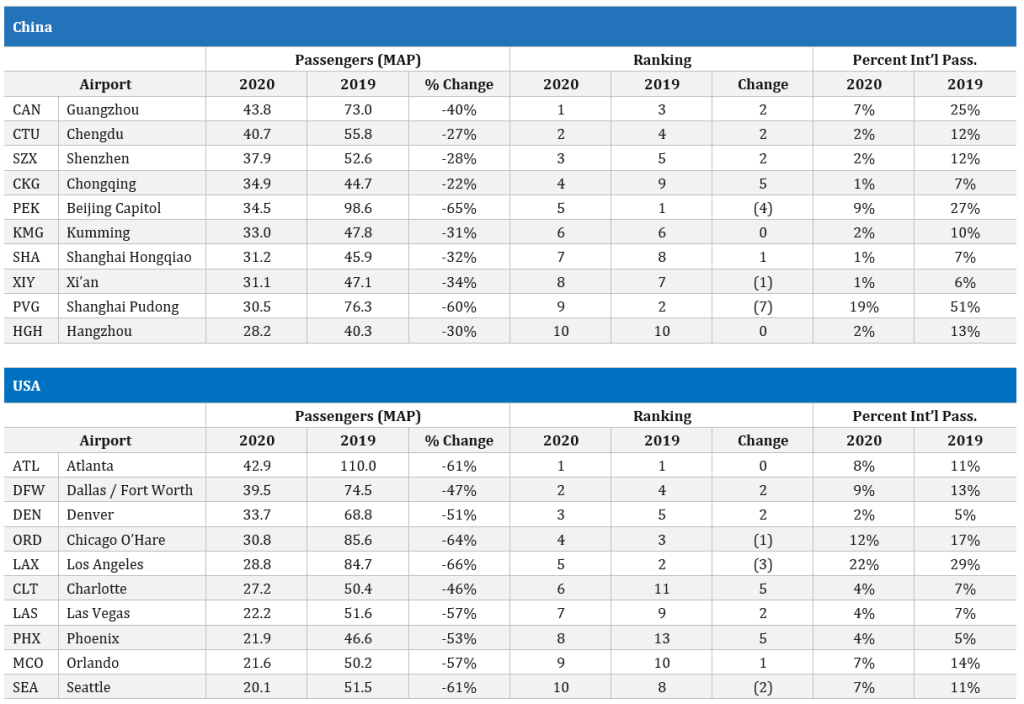
Source: CAAC, Various Airport Websites and L&B Analysis
New York Kennedy International Airport (JFK) and San Francisco International Airport (SFO) dropped out of the top ten rankings because they lost most (over 70%) of their international passengers and many of their domestic passengers. The top ten U.S. airports in 2020 each lost between 47% and 66% of their annual passengers.
The comparison of passenger traffic and airport rankings of China and the U.S. demonstrates that the international sector in both countries as having the greatest losses. The Chinese domestic airport market benefitted from swift government actions that stemmed the first wave of the virus and subsequent actions, which included the implementation of new tools and procedures that airports now use to quickly determine whether passengers are approved for travel by their origination and destination provinces within China.
International Travel Restrictions Vary by Country
Because every country determines their own border controls on international travel, the impacts from the pandemic and international travel cannot be generalized. As of March 2021, 44 countries, mainly in in Africa and South America, have no border restrictions. One hundred and twenty-two countries have partially closed borders, usually restricting travel to their returning nationals and requiring 10 to 14-day quarantines upon arrival. As a result of these varying restrictions on travel, airlines have been returning seating capacity to Central and South America from the U.S., while their capacity to Europe and Asia remains down approximately 75% to 80%.
Border Restrictions by Country
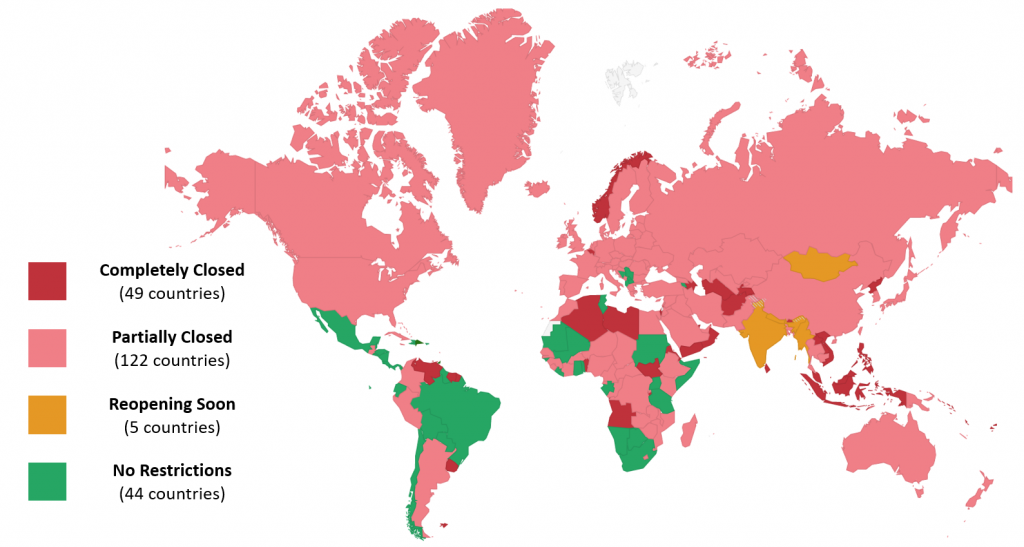
Source: Kayak.com, updated 01/03/2021
Travel This Year
While U.S. travel in January and February of 2021 were below volumes observed in 2019 of November and December, much of this decline was a normal seasonal decline, albeit from a lower base. However, March travel has surged above these volumes. National security checkpoint volumes in March 2021 are the highest since prior to the pandemic.
Airlines have responded by increasing seat capacity to their schedules. Allegiant and Frontier will fly more monthly seats in April in 2021 than they flown in 2019. Spirit’s capacity is only down 10% to 13%. Other carriers have also increased their seating capacities, but capacities are still down by 20% to 45% from 2019.
Monthly Seating Capacity Change Between USA and Other World Areas
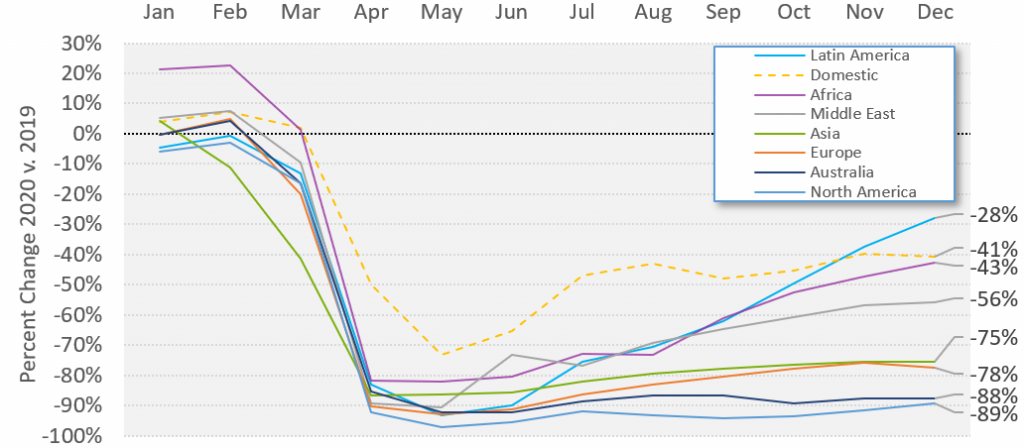
Source: Diio Mi Schedule Data by Cirium
US Airlines Showing Seating Capacity Gains for March and April 2021
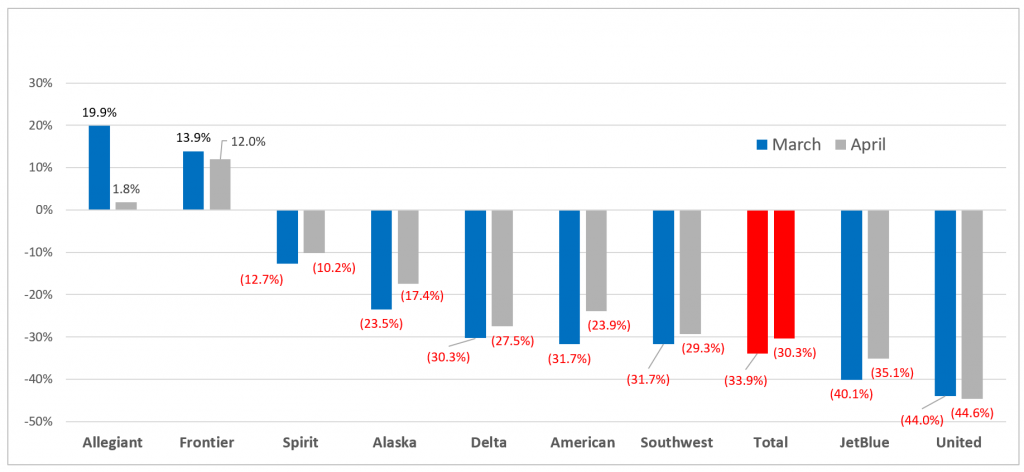
Source: Innovata (via Diio)
By mid-summer, the U.S. should anticipate that approximately 70% to 90% of the population will be vaccinated. As a result, the U.S. will likely achieve herd immunity from the current COVID-19 virus and some of its variants during 2021. The airlines’ and the traveling public’s optimism for the summer travel season appears well founded. U.S. domestic business travel should also resume.
However, the extended period of work-from-home and the business traveler accommodating to online meetings may have a dampening effect. L&B’s previous analyses indicating a longer term 10% to 20% decline in business travel following the pandemic is still applicable. China’s domestic traffic volumes should continue to grow with their domestic economy as the pandemic’s influence on business and leisure demand abates. Besides early control of the pandemic and a robust domestic demand, Chinese carriers and airports have managed to survive COVID-19 in better shape than the U.S which can be attributed to a timely market stimulus measures to bolster passengers confidence put forward by airlines (e.g., China Eastern Airlines’ weekend “All you can fly” promotion).
National USA Security Checkpoint Daily Passenger Counts
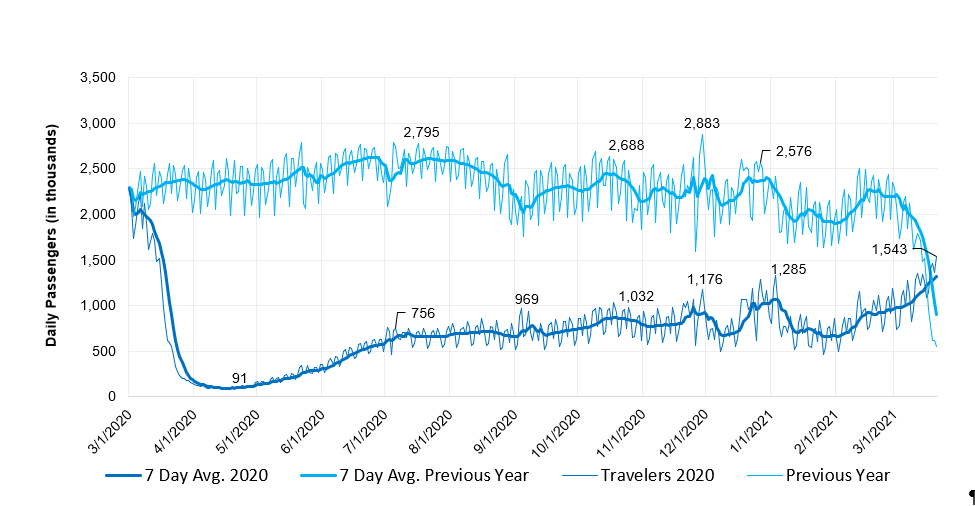
Source: Transportation Security Agency, Checkpoint Travel Numbers – https://www.tsa.gov/coronavirus/passenger-throughput Accessed 22 March 2021
Anticipated Vaccination Completion in East and South Asia Varies Widely
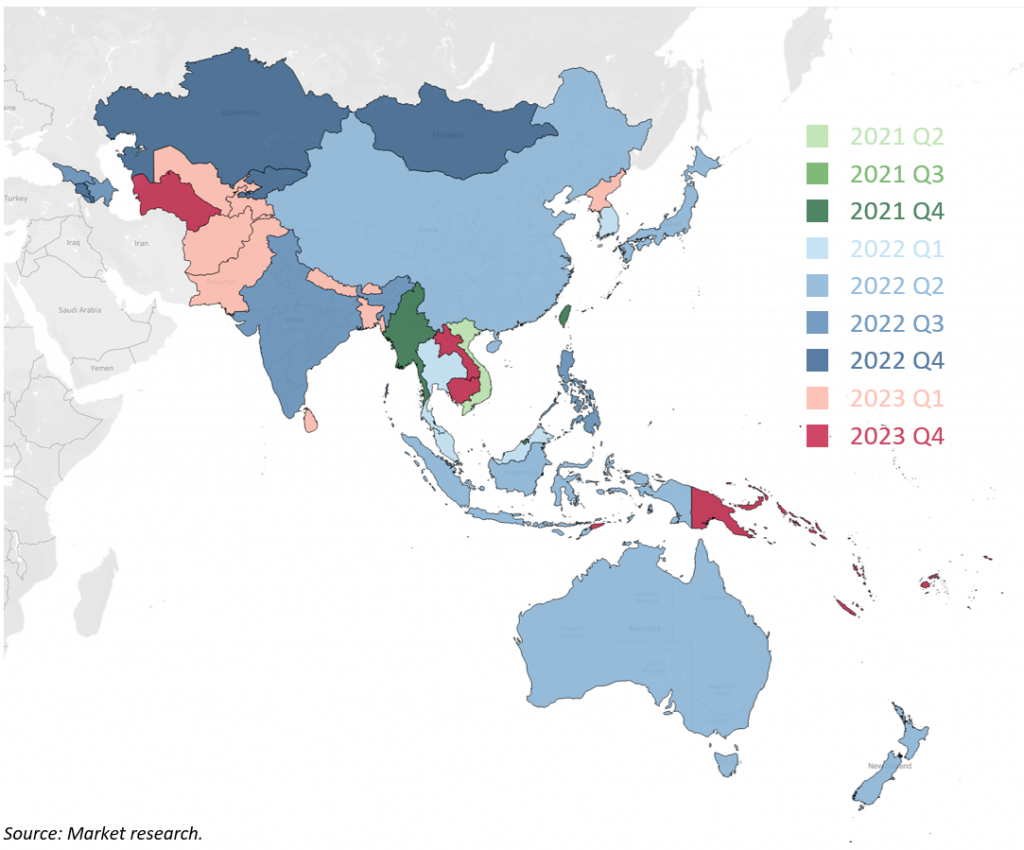
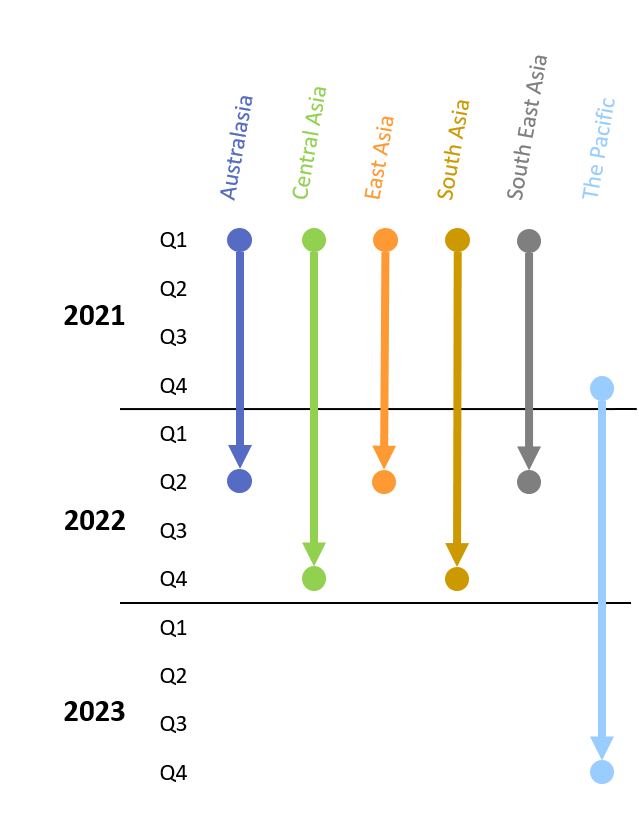
A key element for returning air travel back to normal in both China and the U.S. is the acceptance and universal standard of an application (App) on mobile devices to indicate if a passenger has either received the vaccine or has had a negative test within 72 hours. While a mobile App is the preferred solution, passengers will need the ability to be able to print out a QR code that indicates their vaccination or testing status. While the Chinese experience over the past year has indicated the success and efficiency of using a mobile App and QR codes for travel, this technology and policy has not yet been uniformly adopted worldwide.
Beyond 2021
Countries with large domestic passenger markets like China and the U.S. will likely have their aviation sectors on the road to recovery by the end of 2021, while other countries will take longer because they depend upon restarting international travel to have their aviation sectors begin recovering from the pandemic.
Restarting international air service requires agreement between countries citing evidence the pandemic has been controlled in each or their respective markets and the well-being of the traveler is now safe. According to Raphael Guillet, Chief of the ICAO Asia Pacific Regional Sub-Office, the biggest obstacle to resuming travel in the Asia Pacific Region is the lack of trust between countries.
Given this lack of trust, countries must demonstrate a controlled pandemic through a combination of vaccination and herd immunity. Vaccination progress vary across the Asia-Pacific Region and worldwide. Most large countries will not complete their vaccination programs until early to mid-2022. Other countries will need until 2024. Thus, the return of international travel will be uneven, as pairs of countries regain their mutual trust and negotiate bi-lateral agreements. To enable re-opening of borders without quarantine on a multilateral scale, governments need to be confident they are effectively mitigating the risk of importing COVID-19. This means having accurate information on passengers’ COVID-19 health status. As covered in the February LAB Brief, Industry efforts such the International Air Transport Association (IATA) Travel Pass, which is intended to be a global standardized solution to validate and authenticate COVID-19 passenger travel requirements, will be a key indicator to facilitate standardization. As a result, the time required for governments to reopen the borders remains uncertain and could vary greatly between countries, therefore, slowing down the international recovery process.
Preventing the spread COVID-19 and distributing the vaccine will remain the number one priority worldwide in 2021 and likely into 2022 and beyond.
Airlines Trialing IATA Travel Pass
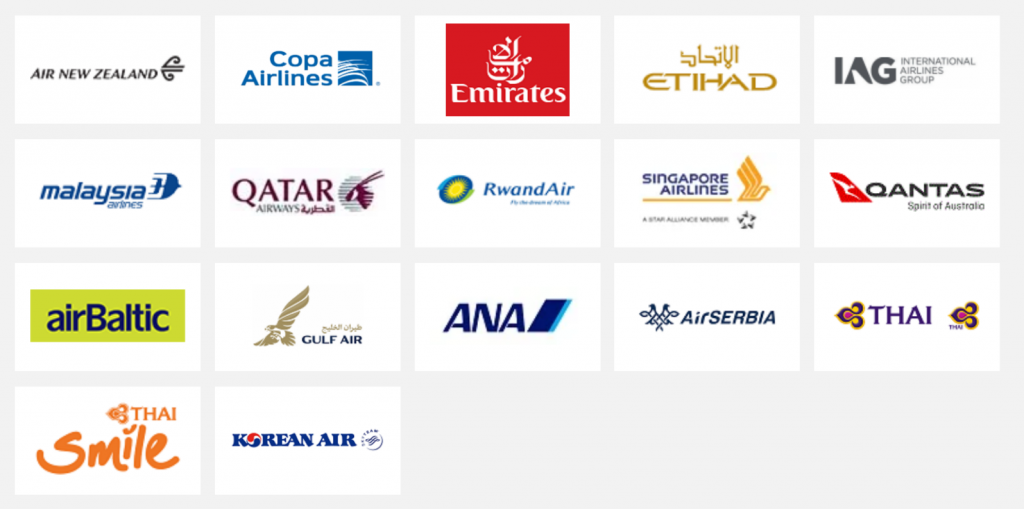
Source: International Air Transport Association
The worldwide hazard is that the virus will mutate to a new form that is immune to vaccines prior to the completion of a worldwide vaccination program. Therefore, the case for facilitating the international distribution of the vaccine is compelling.
Large country aviation systems will continue to weather this pandemic more easily than small countries, due to their airlines having domestic networks that provide at least a portion of their revenues. Small country airlines, which relied almost exclusively on international travel, have lost most of their revenues and traffic. Their airlines will restart from much weaker financial conditions and without substantial government assistance.
Aviation facilitated the worldwide spread of COVID-19 prior to being decimated by its consequences. Restarting international aviation depends on lifting various border restrictions and regaining passenger confidence. A traffic rebound will most certainly occur only with the continuous improvements in rapid COVID testing accuracy and accelerating vaccination programs.
What is the L&B LAB?
The LAB is Landrum & Brown’s research and development unit. Our mission is to harness decades worth of industry knowledge and expertise to develop innovative solutions that support our clients along with promoting industry thought leadership.
This document was prepared by Landrum & Brown, Inc. | [email protected]
Sign up to receive our next L&B LAB in your inbox!



